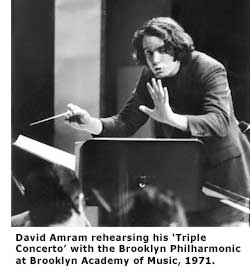Mid-Century Breakthrough: "Third Stream" Music - Page 4

In St. Louis, Tompkins maintained the flow of the Third Stream through his own work, enlisting celebrated jazz players such as baritone saxophonist Pepper Adams and drummer Elvin Jones for recordings on his own label and performances at St. Louis's New Music Circle.
"When I'd started composing [in the early '60s], it almost seemed inconceivable to not combine styles," says Tompkins, 66, who found early inspiration in the MJQ's 'Third Stream Music' album because "it was interesting to know that other people were thinking that way, too."
Enriched and refreshed by their interaction, both jazz and classical forms went on during the remainder of the 20th century to absorb aspects of other genres. Under the influence of innovative rock artists such as Sly Stone and Jimi Hendrix in the late '60s and early '70s, Miles Davis brought electric instruments and funky rhythms into jazz, creating what came to be called simply Fusion.
Both Schuller and the young trumpeter Wynton Marsalis reached back to forms of large-ensemble jazz from the early decades of the century, and they and many others sought inspiration from regional music idioms around the world.
In the new century, Schuller continues to compose, conduct, lecture, write, and issue new and re-released recordings on his own GM label, out of his Boston area home.
'Classical Brubeck' (Telarc), released in 2003, is evidence of Brubeck's persistence, in his ninth decade, as a composer and role model for musical synthesis. On these selections, Brubeck points out, "I leave space, which I usually mark 'optional,' where the quartet can come in and improvise. The London Philharmonic is playing, and then it switches over to us. So it's in real time—it's not like we went back and stuck it in."

Amram remains a champion of several mid-century artists and causes. This year he helped celebrate what would have been Kerouac's 88th birthday in the late writer's hometown of Lowell, Massachusetts; supported his singer/songwriter friend and folk legend Pete Seeger's efforts to protect the ecology of the Hudson River; and carried on the spirit of the Third Stream, literally blowing his own horn in clubs and concert halls and showcasing his compositions for small and large ensembles in a variety of American cities.
Amram's 'Symphonic Variations on a Song by Woody Guthrie' will be performed as part of a gala celebration of Amram's 80th birthday at New York's Symphony Space this fall. Tompkins is among a few who still call Third Stream just that, and he programs it at his New Music Circle in St. Louis.
"I have had pretty good response, when I play some of my music or Gunther Schuller's," he reports. "If you're listening to Third Stream, it's always moving on—from classical to jazz, or jazz to classical—from one mood to another mood. You'll get this variety and contrast of colors and rhythms, and I find that pulls people in." Tompkins even hosts a Third Stream blog on his web site.
Maria Schneider, since Gil Evans' death in 1988, has showcased Evans' legacy and her own evocative, sophisticated creations, which have engaged such classical artists as soprano Dawn Upshaw, the Kronos Quartet, and the St. Paul Chamber Orchestra. Even more so than when the Third Stream was first named, Schneider believes, "it's a particularly good time for all the world to mesh and meld."
From Schuller's perspective, Third Stream "has very much survived and that's the beauty of it, that this concept is an infinitely open-ended one."
After a thoughtful pause, Schuller adds the qualifier, "in the hands of the most creative people. Because if they're not that, then forget about it."
Third Stream essentials

Few recording artists have felt the need to label their products as Third Stream per se. An exception was the Modern Jazz Quartet, whose Atlantic album 'Third Stream Music,' in 1957, helped disseminate the concept in its title and showcase several musicians who'd shown interest, among them Gunther Schuller and Jimmy Giuffre.
More often than not, critics applied the term after the fact to recordings and artists that had no deliberate allegiance to Third Stream, but manifested some elements of classical structure, arrangement, and/or instrumentation within a jazz context. What follows are some very good examples of Third Stream music.




